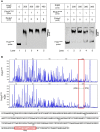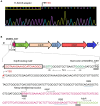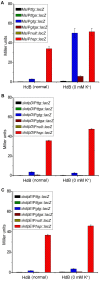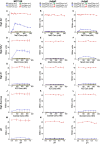Regulation of Inducible Potassium Transporter KdpFABC by the KdpD/KdpE Two-Component System in Mycobacterium smegmatis
- PMID: 28484428
- PMCID: PMC5401905
- DOI: 10.3389/fmicb.2017.00570
Regulation of Inducible Potassium Transporter KdpFABC by the KdpD/KdpE Two-Component System in Mycobacterium smegmatis
Abstract
Kdp-ATPase is an inducible high affinity potassium uptake system that is widely distributed in bacteria, and is generally regulated by the KdpD/KdpE two-component system (TCS). In this study, conducted on Mycobacterium smegmatis, the kdpFABC (encoding Kdp-ATPase) expression was found to be affected by low concentration of K+, high concentrations of Na+, and/or [Formula: see text] of the medium. The KdpE was found to be a transcriptional regulator that bound to a specific 22-bp sequence in the promoter region of kdpFABC operon to positively regulate kdpFABC expression. The KdpE binding motif was highly conserved in the promoters of kdpFABC among the mycobacterial species. 5'-RACE data indicated a transcriptional start site (TSS) of the kdpFABC operon within the coding sequence of MSMEG_5391, which comprised a 120-bp long 5'-UTR and an open reading frame of the 87-bp kdpF gene. The kdpE deletion resulted in altered growth rate under normal and low K+ conditions. Furthermore, under K+ limiting conditions, a single transcript (kdpFABCDE) spanning kdpFABC and kdpDE operons was observed. This study provided the first insight into the regulation of kdpFABC operon by the KdpD/KdpE TCS in M. smegmatis.
Keywords: K+ limitation; Kdp-ATPase; KdpD/KdpE; KdpFABC; Mycobacterium smegmatis; potassium transporter; two-component system (TCS).
Figures










Similar articles
-
Absolute quantification of the Kdp subunits of Escherichia coli by multiple reaction monitoring.Proteomics. 2014 Jul;14(13-14):1630-8. doi: 10.1002/pmic.201300563. Epub 2014 Jun 10. Proteomics. 2014. PMID: 24829208
-
The universal stress protein UspC scaffolds the KdpD/KdpE signaling cascade of Escherichia coli under salt stress.J Mol Biol. 2009 Feb 13;386(1):134-48. doi: 10.1016/j.jmb.2008.12.007. Epub 2008 Dec 11. J Mol Biol. 2009. PMID: 19101563
-
The N-terminal input domain of the sensor kinase KdpD of Escherichia coli stabilizes the interaction between the cognate response regulator KdpE and the corresponding DNA-binding site.J Biol Chem. 2003 Dec 19;278(51):51277-84. doi: 10.1074/jbc.M303801200. Epub 2003 Oct 8. J Biol Chem. 2003. PMID: 14534307
-
The Kdp-ATPase system and its regulation.J Biosci. 2007 Apr;32(3):559-68. doi: 10.1007/s12038-007-0055-7. J Biosci. 2007. PMID: 17536175 Review.
-
The complexity of the 'simple' two-component system KdpD/KdpE in Escherichia coli.FEMS Microbiol Lett. 2010 Mar;304(2):97-106. doi: 10.1111/j.1574-6968.2010.01906.x. Epub 2010 Jan 20. FEMS Microbiol Lett. 2010. PMID: 20146748 Review.
Cited by
-
Achromobacter aestuarii sp. nov., Isolated from an Estuary.Curr Microbiol. 2021 Jan;78(1):411-416. doi: 10.1007/s00284-020-02231-9. Epub 2020 Oct 8. Curr Microbiol. 2021. PMID: 33033853
-
Regulation of potassium uptake in Caulobacter crescentus.J Bacteriol. 2024 Sep 19;206(9):e0010724. doi: 10.1128/jb.00107-24. Epub 2024 Aug 12. J Bacteriol. 2024. PMID: 39133005 Free PMC article.
-
Differential determinants of virulence in two Mycobacterium tuberculosis Colombian clinical isolates of the LAM09 family.Virulence. 2019 Dec;10(1):695-710. doi: 10.1080/21505594.2019.1642045. Virulence. 2019. PMID: 31291814 Free PMC article.
-
Comparative genomic analysis of metal-tolerant bacteria reveals significant differences in metal adaptation strategies.Microbiol Spectr. 2025 Jun 3;13(6):e0168024. doi: 10.1128/spectrum.01680-24. Epub 2025 Apr 24. Microbiol Spectr. 2025. PMID: 40272196 Free PMC article.
-
Genome-wide identification of essential genes in Mycobacterium intracellulare by transposon sequencing - Implication for metabolic remodeling.Sci Rep. 2020 Mar 25;10(1):5449. doi: 10.1038/s41598-020-62287-2. Sci Rep. 2020. PMID: 32214196 Free PMC article.
References
-
- Altendorf K., Gassel M., Puppe W., Mollenkamp T., Zeeck A., Boddien C., et al. (1998). Structure and function of the Kdp-ATPase of Escherichia coli. Acta Physiol. Scand. Suppl. 643, 137–146. - PubMed
-
- Alvarado-Esquivel C., Garcia-Corral N., Carrero-Dominguez D., Enciso-Moreno J. A., Gurrola-Morales T., Portillo-Gomez L., et al. (2009). Molecular analysis of Mycobacterium isolates from extrapulmonary specimens obtained from patients in Mexico. BMC Clin. Pathol. 9:1. 10.1186/1472-6890-9-1 - DOI - PMC - PubMed
LinkOut - more resources
Full Text Sources
Other Literature Sources

